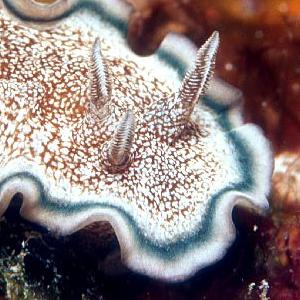
Abnormalities in Body Shape
PHOTO
Anterior end of Glossodoris hikuerensis from Kwajalein, Marshall Islands, showing three rhinophores. See Scott Johnson's message. PHOTO: Jeanette Johnson.
Through developmental mistakes and after damage, animals sometimes grow a weird structure somewhere on their bodies.
Here is a list of relevant messages which are either attached below or elsewhere in the Forum.
-
Oxynoe sp. 3 - 2 tails.
-
Elysia crispata - bifurcate rhinophores.
-
Elysia ornata - conjoined [Siamese] twins.
-
Elysia papillosa - three rhinophores.
-
Hopkinsia rosacea bifurcating rhinophore.
-
Gymnodoris ceylonica fused rhinophores.
-
Nembrotha chamberlaini single median rhinophore.
-
Nembrotha kubaryana three rhinophores
-
Nembrotha kubaryana misshapened rhinophore.
-
Nembrotha purpureolineata trifid rhinophore
-
Kentrodoris rubescens - rhinophore missing.
-
Ceratosoma amoena - branching rhinophore.
-
Ceratosoma amoena - trifid rhinophore.
-
Ceratosoma tenue - dorsal horn absent; 1 rhinophore.
-
Chromodoris africana / Glossodoris rufomarginata - mantle abnormality.
-
Chromodoris annae - trifurcate rhinophore
-
Chromodoris annae - abnormal mantle
-
Chromodoris annae - abnormal mantle
-
Chromodoris annae - abnormal mantle
-
Chromodoris annulata - one rhinophore
-
Chromodoris gleniei - fused rhinophores.
-
Chromodoris hamiltoni - bifid 'tail'
-
Chromodoris hintuanensis- three rhinophores. 2nd record.
-
Chromodoris kuniei - three rhinophores.
-
Chromodoris kuniei - one rhinophore.
-
Chromodoris kuniei - mantle abnormality.
-
Chromodoris kuniei - one normal, one trifid rhinophore.
-
Chromodoris leopardus, 2nd record - 2 anterior mantle flaps.
-
Chromodoris leopardus - mantle damage.
-
Chromodoris lochi - 3 rhinophores.
-
Chromodoris lochi - 2 sets of gills.
-
Chromodoris magnifica - 3 rhinophores.
-
Chromodoris magnifica - cone-shaped outgrowth on mantle.
-
Chromodoris obsoleta - 3 rhinophores
-
Chromodoris orientalis - two heads.
-
Chromodoris quadricolor - cone-shaped outgrowth on mantle.
-
Chromodoris quadricolor - abnormal mantle
-
Chromodoris strigata - mantle abnormality.
-
Chromodoris verrieri - mantle abnormality.
-
Chromodoris willani - 1 rhinophore & cone-shaped growth.
-
Chromodoris willani - cone-shaped growth.
-
Durvilledoris pusilla - bifid rhinophores
-
Glossodoris atromarginata - 4 rhinophores.
-
Glossodoris atromarginata - fused rhinophore pockets.
-
Glossodoris cincta - 1 rhinophore.
-
Glossodoris cruenta - gills beneath mantle skirt
-
Glossodoris hikuerensis - 3 rhinophores
-
Glossodoris sedna - 4 rhinophores
-
Hypselodoris apolegma - abnormal gills.
-
Hypselodoris emma - mantle abnormality.
-
Hypselodoris fontandraui - abnormal gill branching
-
Hypselodoris picta - mantle abnormalities or damage.
-
Hypselodoris zephyra - bifid rhinophore.
-
Hallaxa iju - rhinophores joined.
-
Noumea haliclona - fused rhinophores.
-
Risbecia pulchella - no gills.
-
Risbecia tryoni - cone-shaped growth between rhinophores.
-
Thorunna africana - body damage
-
Phyllidia ocellata - 1 rhinophore.
-
Phyllidiopsis shireenae - damaged anterior end.
-
Reticulidia fungia - double rhinophores.
-
Cuthona sibogae - branched oral tentacle.
-
Phyllodesmium longicirrum - regrown cerata without dig. gland.
-
Phyllodesmium macphersonae - cerata with secondary tips.
-
Phyllodesmium magnum - cerata with double tips.
-
Phidiana hiltoni - 4 rhinophores.
-
Phidiana hiltoni - bifid oral tentacle.
-
Pteraeolidia ianthina - 4 rhinophores
-
Flabellina bicolor - two pairs of oral tentacles.
-
Flabellina exoptata - fused rhinophores.
-
Flabellina pedata - bifurcating oral tentacles.
-
Flabellina pedata- one bifurcating oral tentacle; [Record 2 ]
-
Dirona albolineata - 3 rhinophores.
Rudman, W.B., 2000 (January 28) Abnormalities in Body Shape. [In] Sea Slug Forum. Australian Museum, Sydney. Available from http://www.seaslugforum.net/find/abnormal
Related messages
Chromodoris leopardus with a hood
May 18, 2002
From: Erwin Köhler
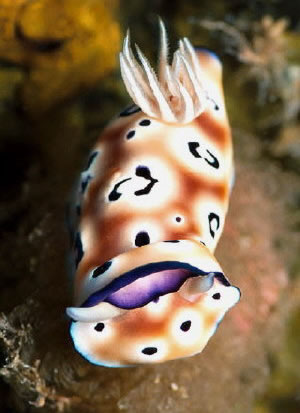
Dear Bill,
Attached is a shot of a Chromodoris leopardus with a 'hood'. It was made by Linda Cline email lscline@dancing-fish.com at the Solomon Islands, wreck of the 'Ann', 04 Nov 2000 - size and depth are not recorded.
Erwin
Erwin@medslugs.de
Köhler, E., 2002 (May 18) Chromodoris leopardus with a hood. [Message in] Sea Slug Forum. Australian Museum, Sydney. Available from http://www.seaslugforum.net/find/6898Thanks Erwin,
When I saw this photo it reminded me of an earlier message. Have a look at Mary Jane's photo, which from the data, is almost certainly the same animal.
Best wishes,
Bill Rudman
Damaged Chromodoris tinctoria f rom Malaysia
July 9, 2001
From: Asther M. Lau
Hi again,
Recently I found a Chromodoris tinctoria at Sea Fan Garden, Tioman, Malaysia.
What puzzles me was the scar that it has on its body. It looked as if it's been torn nearly half its body across and now, instead of having a whole nice body, there is a huge scar on its right side near its head. (if you look from the top). My question is, is there a possibility that this creature could have been bitten and then managed to heal, leaving such a nasty scar on it?
It was about 4cm long. And looked pretty healthy then. What animals could have this beautiful thing for food?
Thank you for your time.
Asther
diveworldwide@yahoo.com
Lau, A.M., 2001 (Jul 9) Damaged Chromodoris tinctoria f rom Malaysia. [Message in] Sea Slug Forum. Australian Museum, Sydney. Available from http://www.seaslugforum.net/find/4751Dear Asther,
It has possibly been bitten by a fish which then spat it out because it tasted bad. Often animals with bright colours also have distasteful glands in their skin so that potential predators learn to leave these bright colour patterns alone. Have a look at the page on Colour & defence for some background information.
I have started a page to record predation observations because there is very little known about what actually eats nudibranchs. Also have a look at the page on Abnormalities where there are links to photos of abnormal body shapes. Some of these are apparently caused by developmental mistakes when the animal was growing, but others are almost certainly the reult of regrowth after predation damage.
Best wishes,
Bill Rudman
Chromodoris leopardus freak
January 10, 2001
From: Mary Jane Adams
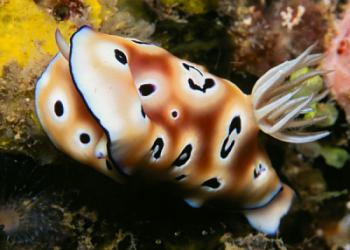
Hi Bill,
Here is one for your abnormal file. I found this Chromodoris leopardus sitting on the Wreck of the Ann in the Russell Group of the Solomon Islands. At first I thought it didn't have any rhinophores. However, when I looked at my slides I saw them peeking out between two flaps at the head end of the mantle. Another diver shot video of this beast a little later when it was crawling and flapping it's mantle. It showed the rhinophores rotating into the usual vertical position when the mantle was lifted. They looked normal as did the single mouth which was located beneath the lower mantle skirt.
Depth: 10 meters
Length: 4 cm
November 4, 2000
Best regards,
Mary Jane
divepng@yahoo.com
Adams, M.J., 2001 (Jan 10) Chromodoris leopardus freak. [Message in] Sea Slug Forum. Australian Museum, Sydney. Available from http://www.seaslugforum.net/find/3482Dear Mary Jane,
A very interesting find. Through some developmental accident it has grown two anterior mantle flaps! Must be difficult for it to know what to do with the rhinophores.
Bill Rudman.
Missing in action
June 27, 2000
From: Mary Jane Adams
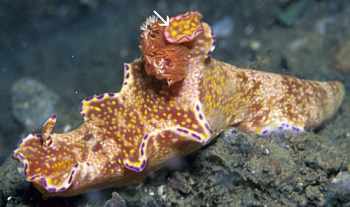
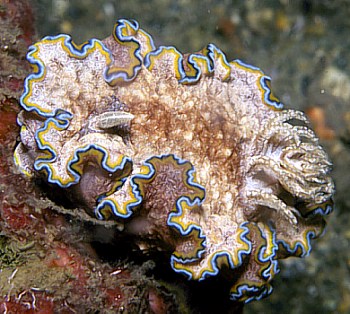
Dear Bill,
I have several photos in my files of nudibranchs with only one rhinophore and I am very curious about them. Has anyone actually observed fish biting them off? Do they regenerate? I have heard that fish generally avoid eating nudibranchs because they taste very bitter. Is it known if fish can detect the bad taste by smelling them? Could some of the missing rhinophores be the result of developmental a defect? I have no photos of branchs with both rhinophores missing. Could they survive if both were bitten off?
UPPER: Ceratosoma tenue on silty sand, 5 meters deep, Alotau, Papua New Guinea, May 22. 1998
LOWER: Glossodoris cincta in a sandy slope, Normanby Island, Papua New Guinea, May 24, 2000
Thanks!
Mary Jane
mjadams@earthlink.net
Adams, M.J., 2000 (Jun 27) Missing in action. [Message in] Sea Slug Forum. Australian Museum, Sydney. Available from http://www.seaslugforum.net/find/2530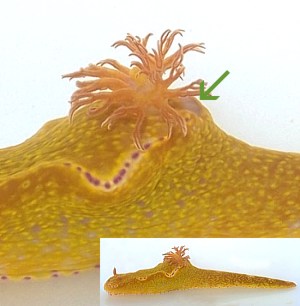
Dear Mary Jane,
When you find an opisthobranch with a bit missing it can have occurred in three ways.
•Injury. This is usually caused by the bite of a predator. Have a look at the Opisthobranch Defence page for some background information. Although many sea slugs have glands and sacs in their skin filled with distasteful chemicals, they only deter predators who know about them. So some sea slugs do get bitten by inexperienced predators. Often the distasteful chemicals cause the predator to spit the slug out, and usually the slugs seem able to withstand quite a bit of damage. In Ceratosoma the dorsal horn (see arrow) contains the distasteful chemicals. It is usually brightly coloured, and I have suggested in the past that it may act as a lure attracting fish to the nastiest part of the body. In the photo alongside is a Ceratosoma tenue from Tanzania with this horn apparently bitten off. The animal was apparently quite healthy, so perhaps it is a useful defence mechanism.
•Autotomy. Some nudibranchs are able to break off sections of their body as a defensive strategy, just like some lizards can lose their tails. each species has a particular 'bit' that is broken off. There are some examples on the Autotomy page.
• Developmental Error. In an earlier message you sent a photo of Chromodoris tinctoria with a funny tube on its mantle. This was clearly a developmental error. I think in both the photos here there is some developmental error as in neither case can I see any sign of the rhinophore pocket into which a 'bitten off' rhinophore normally be able to withdraw. Strangely aberrations with rhinophores seem to occur quite often. Usually it involves fusing of the two, as in Scott Johnson's photo of Gymnodoris ceylonica, but I guess absence is also possible.
Best wishes,
Bill Rudman.
